Baby hatch
A baby hatch or baby box[1] is a place where people (typically mothers) can bring babies, usually newborn, and abandon them anonymously in a safe place to be found and cared for. This kind of arrangement was common in the Middle Ages and in the 18th and 19th centuries, when the device was known as a foundling wheel. Foundling wheels were taken out of use in the late 19th century but a modern form, the baby hatch, began to be introduced again from 1952[2] and since 2000 has come into use in many countries, notably in Germany, where there are around 100 hatches[3][4] and in Pakistan where there are more than 300 as of 2006.[2]
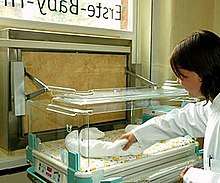
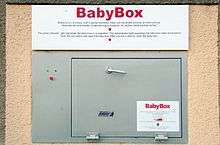
The hatch is known in German-speaking countries as a Babyklappe (baby hatch or flap), Babyfenster (baby window) or Babywiege (baby cradle);[4] in Italian as Culla per la vita (life cradle); in Sicilian as la ruota (the wheel); in Japanese as Akachan posuto (赤ちゃんポスト, baby post box); in Mandarin Chinese as 婴儿安全岛 (pinyin: Yīng'ér ānquándǎo; lit.: 'baby safety island')[5] and in Polish as Okno życia (window of life) and in South Africa originally known as "the hole in the wall" by Door of Hope Children's Mission. The hatches are usually in hospitals, social centres, or churches, and consist of a door or flap in an outside wall which opens onto a soft bed, heated or at least insulated. Sensors in the bed nowadays alert carers when a baby has been put in it so that they can come and take care of the child. In Germany, babies are first looked after for eight weeks during which the mother can return and claim her child without any legal repercussions. If this does not happen, after eight weeks the child is put up for adoption.
History
Baby hatches have existed in one form or another for centuries. The system was quite common in medieval times. From 1198 the first foundling wheels (ruota dei trovatelli) were used in Italy; Pope Innocent III decreed that these should be installed in homes for foundlings so that women could leave their child in secret instead of killing them, a practice clearly evident from the numerous drowned infants found in the Tiber River. A foundling wheel was a cylinder set upright in the outside wall of the building, rather like a revolving door. Mothers placed the child in the cylinder, turned it around so that the baby was inside the church, and then rang a bell to alert caretakers. One example of this type which can still be seen today is in the Santo Spirito hospital at the Vatican City; this wheel was installed in medieval times and used until the 19th century. Another foundling wheel dating to at least 1601 is on display for visitors to Naples' Church of the Annunciata.
In Hamburg, Germany, a Dutch merchant set up a wheel (Drehladen) in an orphanage in 1709. It closed after only five years in 1714 as the number of babies left there was too high for the orphanage to cope with financially. Other wheels are known to have existed in Kassel (1764) and Mainz (1811).
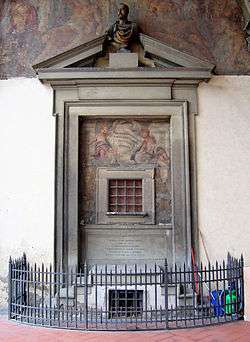
In France, foundling wheels (tours d'abandon, abandonment wheel) were introduced by Saint Vincent de Paul who built the first foundling home in 1638 in Paris. Foundling wheels were legalised in an imperial decree of January 19, 1811, and at their height, there were 251 in France, according to author Anne Martin-Fugier. They were in hospitals such as the Hôpital des Enfants-Trouvés (Hospital for Foundling Children) in Paris. However, the number of children left there rose into the tens of thousands per year, as a result of the desperate economic situation at the time, and in 1863 they were closed down and replaced by "admissions offices" where mothers could give up their child anonymously but could also receive advice. The tours d'abandon were officially abolished in law of June 27, 1904. Today in France, women are allowed to give birth anonymously in hospitals (accouchement sous X) and leave their baby there.
In Brazil and Portugal, foundling wheels (roda dos expostos/enjeitados, literally "wheel for exposed/rejected ones") were also used after Queen Maria I proclaimed on May 24, 1783, that all towns should have a foundling hospital. One example was the wheel installed at the Santa Casa de Misericordia hospital in São Paulo on July 2, 1825. This was taken out of use on June 5, 1949, declared incompatible with the modern social system after five years' debate. A Brazilian film on this subject, Roda Dos Expostos, directed by Maria Emília de Azevedo, won an award for "Best Photography" at the Festival de Gramado in 2001.
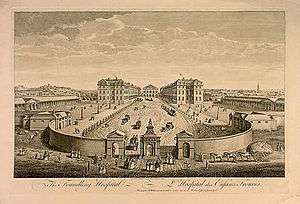
In Britain and Ireland, foundlings were brought up in orphanages financed by the Poor Tax. The home for foundlings in London was established in 1741; in Dublin the Foundling Hospital and Workhouse installed a foundling wheel in 1730, as this excerpt from the Minute Book of the Court of Governors of that year shows:
- "Hu (Boulter) Armach, Primate of All-Ireland, being in the chair, ordered that a turning-wheel, or convenience for taking in children, be provided near the gate of the workhouse; that at any time, by day or by night, a child may be layd in it, to be taken in by the officers of the said house."[6]
The foundling wheel in Dublin was taken out of use in 1826 when the Dublin hospital was closed because of the high death rate of children there.
Modern examples

The first modern baby hatch was in South Africa in July 1999 and was installed by Door of Hope Children's Mission (Hole in the Wall) at a small mission church in Berea in Johannesburg. In 1999 the pastor, Cheryl Allen, and deacons learned with deep distress that a high number of newly born infants were abandoned. Pastor Allen realised that many of those desperate women and girls may well have acted differently if there had been an alternative. The church made a hole in their wall and a "baby bin" was installed allowing for mothers to leave their babies any time, day or night. The moment a baby is placed in the "baby bin" care workers on duty receive an electronic signal alerting them. The baby is taken in and the anonymity of the "donor" ensured. Baby M was the first baby that came through the "baby bin", arriving on 3 October 1999. To date (2013), Door of Hope has received over 1300 babies. 148 have come through the "baby bin" but most come from hospitals, police or community members and some babies have even been brought personally by the mothers.
The second modern baby hatch in Germany was installed in the Altona district of Hamburg on 11 April 2000, after a series of cases in 1999 where children were abandoned and found dead from exposure. It consisted of a warm bed in which the child could be placed from outside the building. After a short delay to allow the person who left the child to leave anonymously, a silent alarm was set off which alerted staff. By 2010, 38 babies had been left in the "Findelbaby" baby hatch in Hamburg, 14 of whom were later reclaimed by their mothers.[7]
The Edhi Foundation in Pakistan offers a similar system.
Reasons for using baby hatches
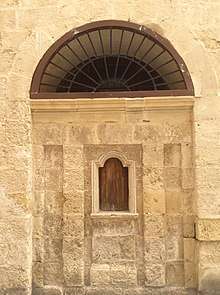
One reason many babies have been abandoned, especially in the past, was that they were born out of wedlock. Today, baby hatches are more often intended to be used by mothers who are unable to cope with looking after their own child and do not wish to divulge their identity. In some countries, it is not legal for mothers to give birth anonymously in a hospital, and the baby hatch is the only way they can safely and secretly leave their child to be cared for by others. In India[8] and Pakistan,[2] the purpose of baby hatches is mainly to provide an alternative to female infanticide, which occurs due to socio-economic factors including the high cost of dowries.
Legal aspects
Some legal problems with baby hatches are connected to children's right to know their own identity, as guaranteed by the UN Convention on the Rights of the Child's Article 8.
Austria
In Austria, the law treats babies found in baby hatches as foundlings. The local social services office for children and young people (Jugendwohlfahrt) takes care of the child for the first six months and then it is given up for adoption. Women have had the right to give birth anonymously since 2001.
Czech Republic
In the Czech Republic, the Ministry of Social Affairs confirmed in 2006 that baby hatches are legal under Czech law. In contradiction to this, in March 2006, Colonel Anna Piskova, a police officer, said on Czech television that the police would look for the mothers of abandoned children. The head of the Czech baby hatch organization Statim,[9] Ludvik Hess, complained about this statement and was officially supported by the Save the Children Foundation. As of April 2019, there are 76 baby hatches in the country, mostly in major cities.[10] So far, they have helped to save 187 children.[11] The United Nations Committee on the Rights of the Child has questioned the legality of baby boxes, criticizing the high number of children's group homes and claiming the boxes violate children's rights.[12][13] Czech internet news server novinky.cz has reported that United Nations wants to ban baby hatches in the Czech Republic.[14]
France
In France, the Vichy government adopted the Legislative Decree of 2 September 1941 on the Protection of Births allowing children to be born anonymously. This law, somewhat modified, became the modern right to anonymous birth (accouchement sous X) set down in the French Social Action and Families Code (Art. 222-6). It covers children up to one year of age. In 2003, the European Court of Human Rights upheld this law,[15] ruling that it did not violate the European Convention on Human Rights.
Germany
In Germany, the baby hatch system only just borders on the legal; normally a mother who abandons her child is committing a criminal act. However, according to the German social laws, parents are allowed to leave their child in the charge of a third party for up to eight weeks, for example if the parents need to go into hospital. After eight weeks, however, the youth welfare office must be called in.
German law considers babies left in the baby hatch as if they have been left in the charge of a third party. This loophole is extremely controversial as there have been some cases in Germany where the baby hatches have been used to abandon disabled children or babies already three months old. Several attempts have been made to clear up the legal basis for baby hatches and how to treat the children left in them, but as yet the situation is still not clearly regulated.
Japan
In Japan, abandoning a baby is normally punished with up to five years in prison. In 2006 officials at Jikei Hospital applied to Kumamoto Prefecture government, Kumamoto city and other offices before opening a baby hatch were told that it would not count as abandonment, as the baby is under the hospital's protection. However, the Japanese ministry of health, labour and welfare would not comment on the issue, apart from saying that there was no precedent.
Malta
- Savona-Ventura, Charles (2015). Knight Hospitaller Medicine in Malta [1530-1798]. Lulu. pp. 67–121. ISBN 132648222X.
Belgium
In Belgium the legal framework is absent, and abandoning babies is illegal, but in practice the babies are placed in foster care and become available for adoption after a few months.
The Belgium hatch operates in a legal vacuum under Belgian law. Even spreading the information is considered "Promoting child abandonment" and those responsible for the existence of the baby Hatch (babyschuif) sensu stricto remain punishable under Belgium law.
Russia
Since 2011, ten baby hatches or so-called baby boxes have come into use in Russia. In less than one year of activity, the boxes helped to save three children.[16]
The charity fund The Cradle of Hope (Колыбель надежды, www.babyboxrf.ru) established in Perm is the main project organizer.[17] Along with installing and setting up baby hatches, the organization works to prevent infanticide, and helps families cope with crisis situations.
The baby hatches are installed in hospitals and run by the wardship and guardianship authority. The law treats babies found in baby boxes as foundlings, who are raised by the State while going through the legal process of adoption.
Senator Elena Mizulina proposed a law to ban baby boxes. In September 2016 it was approved by the Russian government stating that the special places for anonymous abandoning the newborns violate the Convention on the Rights of the Child.[17]
United Kingdom
In the United Kingdom there are no baby hatches, as they are illegal: under section 27 of the Offences against the Person Act 1861 the law states that any mother who abandons a child less than two years of age is a criminal and can face up to five years' imprisonment. In practice, such prosecutions are extremely rare and would only occur if the circumstances of child abandonment showed actual malice, i.e. appeared deliberately intended to result in the death of the child. A mother who wishes to have her newborn baby adopted can do so. Counseling is designed to ensure that giving up the baby is her genuine, irrevocable wish.
Latvia
In Latvia, unless the baby has been reported as missing, the law treats the babies as foundlings.[18]
All baby hatches are located within a hospital's premises[19]. After a baby is left in a baby hatch, the police and custody court are informed about the case and the baby is given a health evaluation and is inspected for signs of abuse. The police during a two day long process find out if the child has been reported as missing, after that the baby is given the status of a foundling and can be put up for adoption.
If the birth parents want to recover a child, they have the option to do so until the child has been officially adopted. The birth parents must prove their parentage by taking a DNA test, which they must pay for themselves. After that custody court reviews the parent's reasons for abandonment and decide whether to allow the parents guardianship of the child.[18] As of May 2018, 5 out of 47 babies left in the baby hatch were returned to their birth parents. [20]
International situation
- Austria – In 2005, six towns had them.
- Australia – There have been various discussions regarding establishing baby hatches.[21][22][23]
- Belgium – The association Moeders voor Moeders ("Mothers for mothers") set up the first babyschuif in the Borgerhout district of Antwerp in 2000. It is known as Moeder Mozes Mandje – "mothers' Moses basket" located in the "Helmstraat". Since its inception, 6 unknown babies were found in the baby hatch in Borgerhout. Another baby (Marieke) was saved after the mother called the emergency telephone while in labor. These have been given "De Kleine" (roughly translated "the small child") as their last name. During the winter 2016-2017, a tenth baby was found in the "babyschuif".
- Canada – In May 2010, St. Paul's Hospital in Vancouver announced the intention to open Canada's first "angel's cradle".[24] By 2014, two more have been introduced in Edmonton[25] and one has been proposed for Toronto.[26]
- Czech Republic – The first baby hatch was set up in July 2005 in Prague by Babybox – Statim.[9] In March 2006, three children had been left there. In December 2007, there were 5 "Babyboxes" in the republic: Prague-Hloubětín, Brno, Olomouc, Kadaň and Zlín, and the next were planned in Pelhřimov, Ústí nad Orlicí, Mladá Boleslav and Sokolov in 2008. From 2005–2007, ten infants were put in baby-boxes, seven of them in Prague. Some of them returned to their mother or were inserted with full documentation. As of December 2011 there were 47, and 62 children had already been left there with one baby box being used 13 times.[27] In years 2005–2019 there have been 76 babyboxes, into which 187 children were put.
- Germany – Baby hatches have been used again since 2000; in 2005 there were more than 80 baby hatches in towns all across the country.
- Hungary – Around a dozen baby hatches, usually run by hospitals. The first opened in 1996 in the Schopf-Merei Agost hospital in Budapest.
- India – In Tamil Nadu state, a baby hatch was set up in 1994 by the then Chief Minister, J. Jayalalithaa, to prevent female infanticide. This kind of baby is called Thottil Kuzhanthai (cradle baby), raised by the state and entitled to free education. In 2002 an "e-cradle" scheme was also introduced in southern India after an abandoned newborn baby was torn apart by dogs in the street near Trivandrum Medical College.[28]
- Italy – About 8 hatches, set up by the "Movement for Life". In December 2006 a modern hatch was installed at the Policlinico Casilino in Rome and in February 2007 it received its first abandoned child. There are also plans to install one at the Santo Spirito hospital at the Vatican City, the home of one of the original foundling wheels.
- Japan – in 2006 the Jikei Hospital in Kumamoto Prefecture announced it was setting up a "storks' cradle" to try to reduce the number of abandoned babies and abortions. As of November 26, 2009, a total of 51 babies had been accepted, and this system has been under the strict guidance of a special committee which pointed out that the acceptance of anonymous babies might reduce the moral philosophy of people.[29] 125 babies had been left at the baby hatch as of March 2017.[30]
- Latvia - the first glābējsilīte ("savior manger") was set up in 2009 in Riga within the Childrens Clinical University Hospital's territory. Since then, seven more hatches were set up in Latvia's biggest towns. As of August 2019, 47 children have been left within a baby hatch, of which five have been reclaimed by their birth parents. [31]
- Netherlands – In 2003 plans to open a babyluik in Amsterdam did not go ahead after heavy protest. State Secretary for Health Clémence Ross suggested that baby hatches were illegal. In years since, the Beschermde Wieg Foundation opened abandoned children rooms in the cities of Groningen, Middelburg, Oudenbosch, Papendrecht, Rotterdam and Zwolle. Women in need can leave their babies anonymously. In 2017 a room in Amsterdam is planned.[32]
- Pakistan – The Edhi Foundation has around 300 centres[2] which offer a jhoola service which is said to have saved over 16,000 lives;[2] the jhoola is a white metal hanging cradle with a mattress, where the baby can be left anonymously outside the centre. A bell can be rung, and staff also check the cradle once an hour.
- Philippines – The Hospicio de San Jose in Manila, founded in 1810 and run by the Daughters of Charity of Saint Vincent de Paul, has a "turning cradle" marked "Abandoned Babies Received Here".
- Malaysia - The first "Baby Hatch" was launched by a non-profit NGO, OrphanCare Foundation in 2010. By end of 2016 OrphanCare had saved over 200 babies and has two more baby hatches in state of Kedah and Johor. In 2015 OrphanCare signed MoC with KPJ Healthcare to manage the adoption of babies placed in baby hatches in 8 of KPJ Hospitals in major cities in Peninsular Malaysia. KPJ also have a baby hatch each in Sabah and Sarawak.
- Poland – In 2012, forty-seven towns had them.
- South Africa – The non-profit organisation "Door Of Hope Children's Mission" set up a "hole in the wall" in July 1999 at the Mission Church in Johannesburg. By March 2013 around 148 babies came through the hole in the wall but over 1300 babies have come through their doors.[33]
- South Korea – Pastor Lee Jong-rak operates a "baby box" in his church in southwest Seoul. Before the Special Adoption Law was passed in August 2012, Mr. Lee says the baby box received an average of about two newborns per month, but that number has risen to about 19.[34]
- Switzerland – There are two baby hatches operating in Switzerland, one at the Einsiedeln hospital since 2001 and another one at the Davos hospital since 2012.
- United States – Two baby hatches started operating in the state of Indiana in 2016.[35][36] Baby hatches as such are not known elsewhere in the United States; however, all 50 states have introduced "safe-haven laws"[37] since Texas began on September 1, 1999. These allow parents to legally give up their newborn child (younger than 72 hours) anonymously to certain places known as "safe havens", such as fire stations, police stations, and hospitals. The laws have different names in different states, e.g. California's Safely Surrendered Baby Law[38] and some have different age limits, e.g. Nebraska's safe-haven law as originally written had no age limit, allowing all children under 18 years of age to be abandoned; this was amended on November 2008.[39]
Cultural references
- In the novel Anthony Adverse by Hervey Allen, the main character is left in the foundling wheel of a convent in northern Italy.
- This type of abandonment is the main theme of a historical novella set in nineteenth-century Sicily, The Lady of the Wheel, by Angelo F. Coniglio.
- "The Gap of Time"[40], by Jeanette Winterson is a modern interpretation of The Winter's Tale in which her equivalent of Shakespeare's Perdita, instead of being abandoned on an island, is placed in a baby hatch in the fictional American city of New Bohemia.
- "Another Foundling Wheel," a poem by the American poet, Scott Harney, was inspired by the foundling wheel in Naples at the Church of the Annunciata. Found in the 2020 book of his poems, The Blood of San Gennaro, "Another Foundling Wheel" reveals the writer meditating on life and death: "Sometimes inside a foundling wheel_each of us is spun, and we spill into the arms of nuns_or we spin lost forever...."
See also
- Child abandonment
- Harm reduction
- Maternity package, a cardboard box full of all the items needed for a baby's first year, also known as a baby box
References
- Parco, Nicholas. "First baby drop-off boxes for unwanted infants installed in Indiana". nydailynews.com. Retrieved 2019-06-27.
- Hibbert, Katharine (2006-05-21). "The Child Catchers". London: The Times. Archived from the original on 2008-12-02. Retrieved 2008-06-30.
- Emma Thomas (2013-11-27). "The 'revolving door' baby hatches for abandoned newborns in German hospitals where mothers get eight weeks to change their mind". Dailymail.co.uk. Retrieved 2013-12-11.
- The 'baby box' returns to Europe, BBC News, 26 June 2012
- Gao, Jing. "Chinese city sets up baby hatch to tackle child abandonment". Ministry of Tofu. Archived from the original on 9 March 2012. Retrieved 8 March 2012.
- "First Hospital in Dublin - Poor Relief in former days - The Foundling Hospital and its Founders". Archived from the original on 2006-05-01. Retrieved 2006-05-01.
- "Baby hatches turn 10 amid calls for closure - The Local". Thelocal.de. Retrieved 2013-04-21.
- Cradles plan for unwanted girls BBC News, 18 February 2007
- Ondřej Tůma (McBig). "BABYBOX úvodní stránka". Retrieved 13 April 2016.
- Ondřej Tůma (McBig). "BABYBOX Statistiky babyboxů". Retrieved 13 April 2016.
- Babybox někdo otevřel a zavřel, holčičku pak dvě ženy předaly sestrám(in Czech)
- Committee on the Rights of the Child reviews report of the Czech Republic, United Nations, 31 May 2011
- Committee on the Rights of the Child, Concluding Observations: Czech Republic, CRC/C/CZE/CO/3-4, Committee on the Rights of the Child, Fifty-seventh session, 30 May – 17 June 2011 (4 August 2011)
- "OSN kritizovala ČR za děti v ústavech, chce zrušit babyboxy". Novinky.cz. Retrieved 13 April 2016.
- odièvre – 42326jnv.gc 13022003e
- "Babybox в России". Archived from the original on 2016-04-09. Retrieved 13 April 2016.
- "Мизулина сообщила об одобрении правительством запрета на бэби-боксы", lenta.ru, September 28, 2016
- Calis.lv (2018-06-01). "'Baby Box' Latvijā". delfi.lv (in Latvian). Retrieved 2019-12-29.
- "Glābējsilītes Latvijā – babybox.lv". babybox.lv (in Latvian). Retrieved 2019-12-29.
- "Glābējsilītes projektā iesaistītie sabiedrību lūdz nenosodīt mātes, kuras atstāj savu mazuli glābējsilītēs". skaties.lv. Retrieved 2019-12-29.
- "Australian authorities consider 'baby hatches' for unwanted newborns". The Telegraph. December 1, 2014.
- Ambrose, Margaret (January 25, 2015). "Baby hatches: the safest solution for abandoned newborns?". Herald Sun. Retrieved May 13, 2017.
- Barden, David (February 24, 2016). "Australia, Is It Time To Introduce Baby Boxes And Safe Haven Laws?". The Huffington Post. Retrieved May 13, 2017.
- Hospital to open drop-off for abandoned babies, CBC News, April 29, 2010
- , CBC News, May 6, 2013
- , Toronto Star, June 7, 2013
- V Mělníku začal fungovat jubilejní třicátý babybox (in Czech)
- Hindustan Times: Kerala e-cradle gets 100th child, a girl
- "【魚拓】asahi.com(朝日新聞社):赤ちゃんポスト、08年度は24人 熊本・慈恵病院 - 社会". ウェブ魚拓. Retrieved 13 April 2016.
- "Kumamoto baby hatch still delivers hope 10 years on". Japan Times. April 15, 2017. Retrieved May 13, 2017.
- "Glābējsilītes projektā iesaistītie sabiedrību lūdz nenosodīt mātes, kuras atstāj savu mazuli glābējsilītēs". skaties.lv. Retrieved 2019-12-29.
- "Beschermde Wieg Foundation :: News, Press & Publications". www.beschermdewieg.nl. Retrieved 2019-06-27.
- "'Baby bin' to save South Africa's unwanted children". BBC News. March 16, 2011.
- "Change in Korean Adoption Law Followed by More Abandoned Babies". The Wallstreet Journal. October 7, 2013.
- Silva, Daniella (May 5, 2016). "Indiana Installs 'Safe Haven Baby Boxes' for Abandoned Newborns". NBC News. Archived from the original on May 5, 2016. Retrieved May 6, 2016.
- "Baby in the box: Safe haven infant hatches arrive in US". RT. May 5, 2016. Archived from the original on May 6, 2016. Retrieved May 6, 2016.
- "Nebraska's "Safe Haven" Law Allows Parents To Abandon Unwanted Children". The Huffington Post. August 22, 2008.
- Safely Surrendered Baby Law, Los Angeles County
- Neb. Lawmakers Put Age Limit On Safe Haven Law, NPR, November 21, 2008
- "The Gap of Time".
External links
| Wikimedia Commons has media related to Baby hatches. |
- . Encyclopædia Britannica. 10 (11th ed.). 1911. pp. 746–747.
- Germany Still Divided over the Idea of Baby Hatches – Article from Deutsche Welle website (English)
- Hospital to bring back abandoned baby wheel – Article from The Times newspaper, UK (Article behind a pay-wall)
- www.babyklappe.info German language website of baby hatch producer
- List of all baby hatches in Germany (in German)
- Retour vers le XIXe siècle Article in French from le Courrier, Switzerland
- L'évolution des modes d'abandon from the Histoire et Patrimoine des hôpitaux de l'Assistance Publique – Hôpitaux de Paris
- Door Of Hope, South Africa
- Japanese newspaper articles, at Japanese Children's Rights Network
- Netherlands Institute for the Documentation of Anonymous Abandonance – Dutch website on foundlings and neonaticide